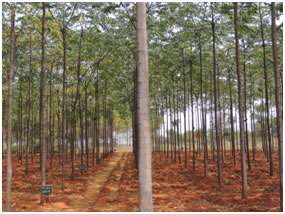Melia dubia (MalaiVembu) originates from the Meliaceae family and is an indigenous species of tree to India, South East Asia and Australia, where it has been cultivated as a source of firewood. Melia dubia is also called as a Mahaneem or Forest neem which is fastest growing tree species and within 6-7 years the plantation is ready to harvest. The wood is having good demand from ply wood and paper industries.
A height of 20.m with a spreading crown and a cylindrical straight bole of 9 m length and 1.2 – 1.5 m girth. The bark is dark brown, exfoliating in thin, narrow strips with broad, shallow, longitudinal cracks. Leaves bi-pinnate or occasionally tri-pinnate. Leaflets ovate – Lanceolate to ovate round, entire or crenulate; flowers greenish white, fragrant, intense panicles; fruit an ovoid or ellipsoid drupe with 5 or less seeds.
Distribution
It occurs in tropical moist deciduous forests, and yields a useful timber. It occurs in Sikkim Himalayas, North Bengal and upper Assam, Khasi hills of Orissa, N.Circars, Deccan and Western Ghats at altitudes of 1,500 – 1,800 m.
Environmental requirements
It grows on variety of soils .However deep fertile sandy loam soils shows optimum growth, while shallow gravelly soils shows stunt growth. The tree is a light demander, the seedling are suppressed under shade. Seedlings tolerate some frost but severe frost kills them. It is susceptible to damage by fires and sapling suffers from browsing. The trees are sensitive in water logged conditions. |

